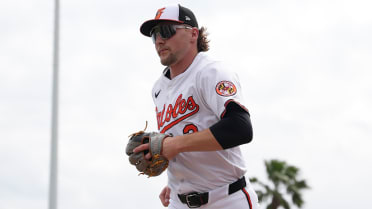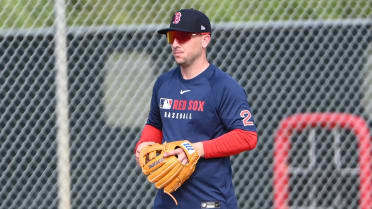This might be the pitcher to watch in 2024
Detroit lefty had 43 strikeouts, just four walks in final month
Tarik Skubal was the best starting pitcher in baseball last season, which is a purposefully inflammatory statement absolutely meant to make your eyes pop out of your head. (“Who? The guy who won seven games and received zero Cy Young votes?”)
We’re here to bring the heavily caveated receipts, because his ability to turn a great half-year into a full season of 2024 dominance is going to say everything about whether his Tigers can post their first winning season since 2016.
Skubal posted a 2.80 ERA in 80 1/3 innings last year, all coming in the final three months of the season after rehabbing for nearly a year to return from flexor tendon surgery. You don’t need to be told that a 2.80 ERA is good -- it is -- but here in 2024, we have a veritable alphabet soup of metrics that help us tell a deeper story. Looking at all 172 pitchers last year who threw at least 80 innings, look where Skubal’s advanced metrics placed him:
Those are all variously complex ways of attempting to get past the luck and team influence that can be present in ERA to try to get to what’s “real." While they all do it in very different ways, the answer is unanimous: Real. What Skubal did in those 80 innings wasn’t a fluke, or mere good luck. It was based on the kind of dominance that comes with striking out 102 hitters while walking a mere 14 and allowing a slugging percentage of only .298.
It got even better as the season progressed. In September, when he was the AL Pitcher of the Month while allowing three runs in five starts with a 43/4 K/BB ratio, he allowed a line of .135/.174/.192. It was the second-best pitching month ever posted in the modern history of the Tigers, a team that has been around basically forever.
It was, of course, just 80 innings, and that September came against some terribly weak lineups. That’s the caveat. Skubal being tremendous for 80 innings is not as valuable as Gerrit Cole or Zack Wheeler or someone else being tremendous for 190 innings. But we know the skill is for real, and that’s the hard part. What’s left is doing it over a full season, which is obviously easier said than done. Looking ahead to 2024, FanGraphs projections have him as the eighth-best starter in the game, backing up that confidence.
“He’s one of the best pitchers in baseball, quite honestly, when he’s right,” manager A.J. Hinch said after Skubal's July 4 season debut.
OK, so: What does it look like when he’s right?
Skubal, a ninth-round pick out of Seattle University in the 2018 Draft, made it to the Majors in 2020, but it took him a while to get his footing. After a 4.57 ERA across his first two seasons, Skubal arrived at camp for 2022 with much to prove. A 3.52 ERA at 25 years old showed improvement -- even more than that if you notice that the 3.31 xERA and 2.96 FIP were even lower -- until his season ended in August with soreness that led to surgery.
He spent his rehab time working on his form.
“I’ve been able to make some tweaks to my mechanics,” Skubal told MLB.com’s Jason Beck in May. “This throwing program, I’ve been able to hammer out some kinks that are going to take a little bit of stress off the arm and help use my body the right way. That’s the positive for me that I’m going to take out of this.”
If “using [his] body the right way” is what led to this, then consider it time well spent, because if we could oversimplify Skubal’s improvement into one chart, it would be the one that shows the jump in his four-seam velocity.
In his first three seasons, fewer than one-third of his fastballs (30.5%, to be exact) were 95 mph or harder. In 2023, he averaged 95.8 mph. Only three lefty starting pitchers threw harder.
It took all of eight batters into his 2023 return to show exactly what that meant, when he used that four-seamer on Oakland’s Nick Allen to make one of the more viral moments of the summer. It’s one thing to get a swinging strike; it’s another thing to make a professional hitter look like that, especially on a fastball. (Yes, that’s a sword.)
But in order to really see what’s different about Skubal now, we’re going to have to get a little wonky. Don’t worry. We’ll keep it simple, with pictures, and break it down into three big changes.
1) He’s throwing from a different spot on the mound now.
Just compare a game from his rookie season to one from 2023, both in Chicago’s Guaranteed Rate Field against a right-handed batter with no runners on. He’s moved a full foot on the mound (pink square), from the first-base side to the third-base side. Also worth noting: When his leg reaches its highest point, he no longer brings his hands all the way to his face (green circle), instead leaving them closer to his shoulders.
It's a clear choice made for 2023, that this would give him the look he was searching for against the opposition.
2) He’s made his changeup move much differently.
As a rookie, Skubal’s changeup wasn’t very good (.538 SLG against, and -3 run value). In 2021, it was better, but it was also his fourth most-used pitch, at 12%. In 2022, it was almost exactly the same: a decent pitch, but since he only threw it 15% of the time, it was his fourth pitch.
In 2023, he threw it 25% of the time, second behind only his fastball, but even that undersells it. In September, he had his best month while using his changeup as his primary pitch for the first time in his career, throwing it 46% of the time. (In place of what? As a rookie, he’d thrown his four-seamer nearly 60% of the time. In Sept. 2023, that was a mere 29%.)
If you’re throwing your changeup that often, it’d better be a good one. It is. But it’s a different one now.
We know that in 2021, he attended Driveline and fiddled with the grip on his changeup. “I went through about every grip you could think of for a changeup,” he said referring to his pitch-design sessions, “before I found … [the one] that gets the results I want.”
You can see exactly what the results were here:
Consider this:
- In 2020, that changeup dropped 25 inches and broke 9 inches horizontally, each below average.
- In 2023, that changeup dropped 34 inches and broke 13 inches horizontally, each above average.
That’s a massive difference -- note that he’s also added 1 mph of velo as well -- and it’s the culmination of improvements that have happened slowly each season. What we’re seeing here seems to be a much better usage of seam-shifted wake, which is a very fancy science term that essentially means using the seams of the baseball themselves to gain extra or unexpected movement on the baseball.
What’s happening here is about the orientation of the ball on the way to the plate. In 2020, and in 2021, the direction of the spin on Skubal’s change was 10:45 on a clock, from the pitcher’s point of view, and that’s exactly the direction of the movement, too. Last year, though, the spin at his release point was at 10:30 on a clock, yet the movement on the way to the plate was at 9:30. It’s an oversimplified way of saying that he was using the seams to catch the air and make the ball move in extra ways -- to make the spin axis change after leaving his hand.
Put it this way: In 2020, only 17% of Skubal’s changeups had at least two inches of sideways movement that could be attributed to seam-shifted wake. The next year, it was 35%. The last two seasons? North of 90%. It seems the new Tigers pitching lab might be paying off.
3) He’s tunneling his fastball and his changeup much differently.
When you look at this graph, showing his release points, there’s really only one thing worth noticing. It’s not the shape. It’s not the numbers. It’s that the two lines here, for changeup (green) and fastballs (red) have A) flipped and B) drawn close together.
In Skubal’s first three seasons, his changeup was released higher than his fastballs. In his first two seasons, it was a lot higher. It’s not necessarily better or worse that the fastball used to come out lower than the changeup and now it’s higher, but it’s definitely noticeable that the gap here has shrunk to the point that there’s essentially no gap at all.
In 2021, it was noted that Skubal was “trying to perfect the art of pitch tunneling,” as the Detroit Free Press wrote. If half the point of a changeup is to look like a fastball right until it doesn’t, then making it more difficult for a batter to tell them apart out of your hand -- to say nothing of having it move more -- would seem to be a good approach.
“I kind of expect Skubal to be a monster every time out,” Hinch said after that first game back against Oakland in July. For 15 starts -- setting aside one lousy outing in Kansas City -- he was. The breakout isn't about to happen. It already has. All that's left is to keep it going.
Mike Petriello is a stats analyst for MLB.com, focusing on Statcast and Baseball Savant, and is also a contributor to MLB Network.




